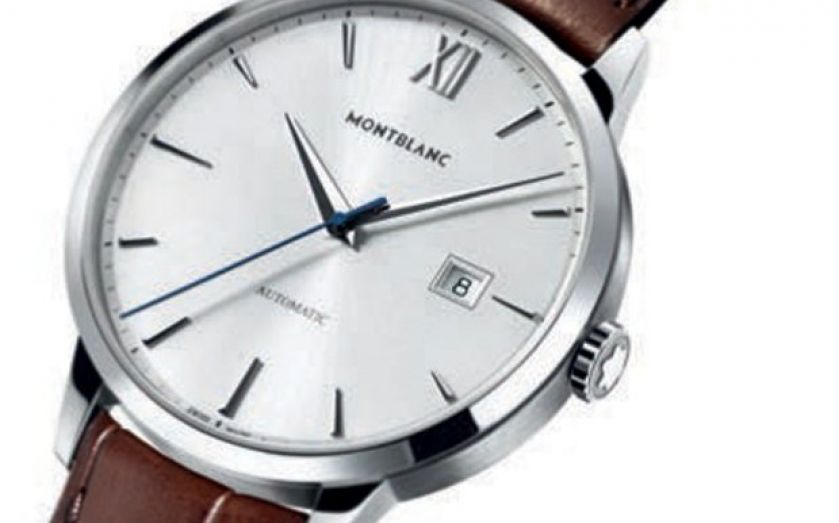An understated Montblanc coup

The Meisterstück Heritage collection is surprising in all the right ways
SIHH is not exactly known for its restraint. It’s the chance for some of the watch world’s most capable brands to show off; consequently one is usually beset on all sides by skeletonised tourbillon watches that can tell the time on Mars. The total carat weight of diamonds on show is easily enough to stun a bison.
Not a place, then, where you might expect to find a whole new collection of elegant, functional, normal-sized watches. But that’s exactly what Montblanc announced: the Meisterstuck Heritage collection is all of those things and – for what it is – surprisingly grounded when it comes to price.
Stylophiles may recognise the collection name – it harks back to the first production in 1924 of the brand’s flagship fountain pen.
Alexander Schmidt, managing director of watches at Montblanc explains: “It’s not a watch collection that looks like a fountain pen, not at all. The pen is one of a few things that stand for the essence of the Montblanc brand. It’s a symbol of perfect quality and high functionality, and it has stood for that for 90 years. The new watch collection embodies that spirit, from the high complications to the simple three-handed automatic.”
Aside from their looks and their price-tags – both of which are appealing – the Meisterstuck watches were attracting a buzz among watch fans for the implications they might have for Montblanc as a whole.
This collection sees unprecedented collaboration between Montblanc’s two centres of watchmaking: its own in-house manufacture at Le Locle, and the prestigious house of Villeret, which – then called Minerva – it acquired seven years ago.
As Schmidt says, “Villeret has a unique history, with over 150 years of watchmaking experience. Le Locle is where traditional Swiss watchmaking meets technology, and is where we do all our quality testing. Both have different strengths, which are combined in the Meisterstuck Heritage collection.
The collection consists of a three-hand automatic with a date window; a moonphase automatic; a perpetual calendar and the Heritage Pulsograph. The limited edition Pulsograph tops the range at £22,500, and is a real beauty, with a variation on the tachymetre scale common to racing chronographs – the gradations are set to enable easy measure of a patient’s pulse.
But it’s the Perpetual Calendar that deserves the plaudits – mostly for showing that such a complication needn’t cost the earth. Perpetual calendars need no re-setting at the month’s end, and factor leap years into the equation. They are fiddly complications, and if you were shopping elsewhere, could easily cost £20,000. This one – which won’t need adjusting until 2100 – comes in at £8,500 in steel. Granted, it’s not an in-house movement, but even so, it’s fairly compelling.
Schmidt is coy on the finances, but acknowledges that the collaboration has enabled the brand to offer something exciting at a slightly surprising price. “It’s not necessarily a question of money; we tried to make detailed, perfect watches. But each model brings a complication into a segment of the market where it’s not usually found. The €2000-5000 market has always been strong for us, with the TimeWalker and the Star Classic. But this is a completely different aesthetic.”
Lest you worry that these prices represent some kind of compromise, it’s worth mentioning that each Meisterstuck is given a rigorous 500 hour quality test at Le Locle – another example of the exchange of knowledge between sites that, according to Schmidt, isn’t stopping here.
“We will absolutely be expanding the Heritage collection in years to come, and we will continue to combine the strengths [of Villeret and Le Locle]. Some movements will stay at Villeret, while some elements might come over to other collections. It’s definitely going to happen more. In the future we will develop our own movements at every sector of the market.”
An auspicious brand heritage
The introduction of the Meisterstuck pen in 1924 marked a watershed moment for the young brand, introducing a top-end model that would last for decades. It was the first Montblanc pen to bear the number 4810 on its nib – relating to the height in metres of the mountain above sea level. The black resin barrel and cap, with plain gold band, have been held in the hands of monarchs and presidents in their time.
Montblanc is also well-known for more literal ties between writing and time-keeping; the brand’s Nicholas Rieussec line of chronographs are constructed along the same lines as the original chronograph that Rieussec invented at the Champs-de-Mars horse racing in Paris in 1821.